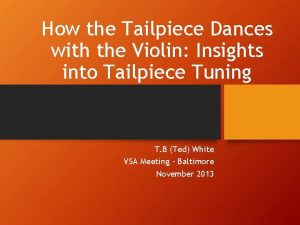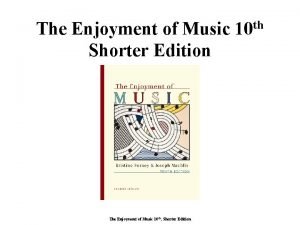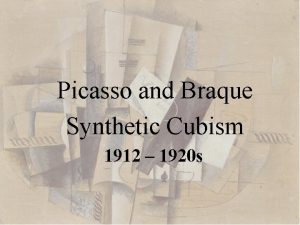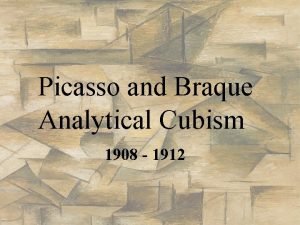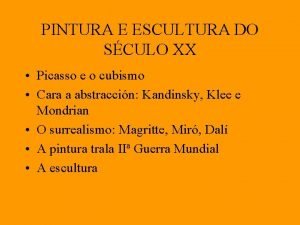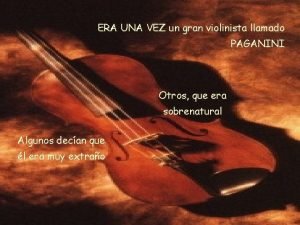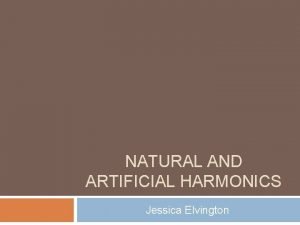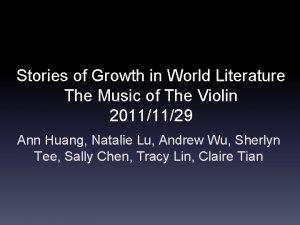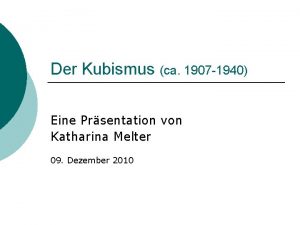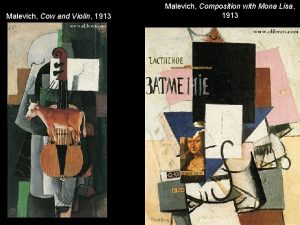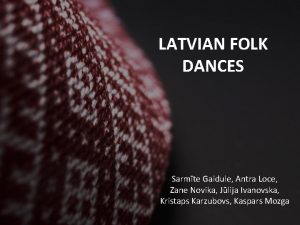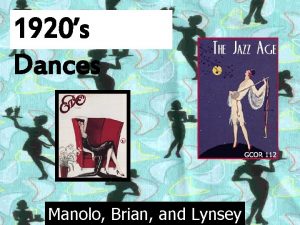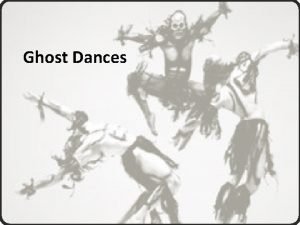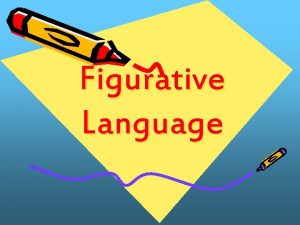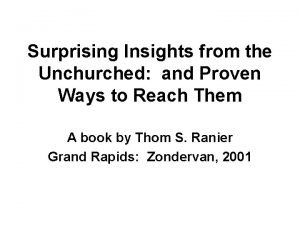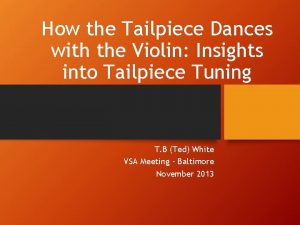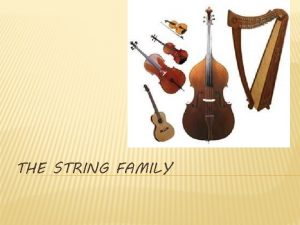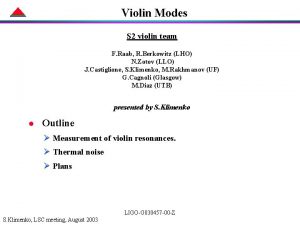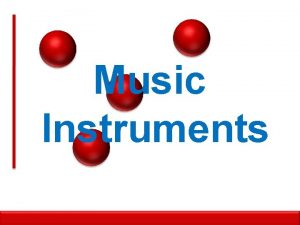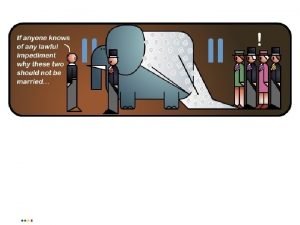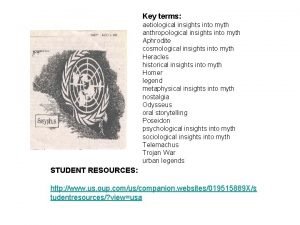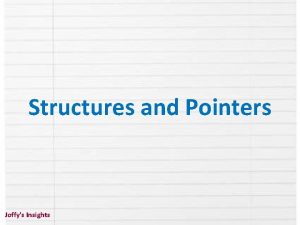How the Tailpiece Dances with the Violin Insights







































- Slides: 39

How the Tailpiece Dances with the Violin: Insights into Tailpiece Tuning T. B (Ted) White VSA Meeting - Baltimore November 2013

What Is The Ideal Tonal Adjustor? • • • No modification of instrument required Inexpensive Does not require adding parts Adds flexibility to the setup process Does not require string take-down

Desirable Possible Effects • Tonal “quality” improvement • Playability improvement • Wolf note management

Sinks and Sources • Think of energy flowing around in the instrument from various sources into sinks • Bow into string into bridge into instrument body • But what about the other way around? • And what about the tailpiece and nut?

Helmholtz Motion of a String Bridge Reflection Tailpiece Instrument Body Nut Reflection

Tailpieces • • • Tailpieces are easy to work with They are attached directly to the strings Likely to affect bridge mobility Likely to act as part of a mass damper Certain modes of the afterlength/tailpiece/tailgut system may be close to the wolf

Tonal Changes Are Known To Occur With: • • • Afterlength adjustment Tailgut adjustment or change Changing tailpieces Weighting tailpieces Carving or lightening tailpieces

Possible Theoretical Basis • Mass resonator as a rigid mass and sprung suspension • Damping via flexure of the tailpiece • Sympathetic vibration of after-lengths (Tuning to 1/6 th rule etc. ) • Radiation damping

Rigid Body Mass Resonator Factors • Tailpiece mass distribution • Elasticity and tension of string after-lengths and tailgut • Lengths of afterlengths and tailgut • Other mechanical properties of strings and tailgut

Simple Mass and Spring Systems

Flexural Damping Factors • • Wood properties of the tailpiece Sectional properties of the tailpiece shape Mass distribution Boundary conditions at supports

Identified Tailpiece Modes • Stough, 1996, CASJ 3, Series II showed for violins: • 3 “swing” modes below open G (roll) • 2 rotational modes • About a vertical axis (yaw) • About a horizontal axis (pitch) • E. Fouilhe, et. al. 2011, measured 9 modes for cello both rigid and flexural

Afterlength Tuning Factors • • • Presumed interval or length ratio Length of tailpiece vs. length of tailgut Effect of silking Effect of fine tuners Effect of end type – loop or ball Mute or wolf eliminator mass

Frequency Response Functions of Nine Cello Tailpieces

Tailgut vs. Afterlength Pitch Mode Yaw Mode 800 900 700 800 600 700 600 Hz Hz 500 400 300 500 16 mm tailcord 400 16 mm tailcord 8 mm tailcord 300 8 mm tailcord 200 100 0 40 50 afterlength mm 60

Tailpiece Survey Conclusions • Pitch and Yaw modes dominate rigid body modes • Pitch mode closest to wolf note • Tailgut length more important than afterlength in rigid mode resonances • Higher modes highly variable

Finite Element Analysis (FEA) • • • Computer analysis Accurate material and structural models Possible to predict stress and strain Possible to predict structural acoustics Very useful in design

Cello Tailpiece Pitch Modes

Cello Tailpiece Yaw Modes

Cello Tailpiece Roll and Translate Modes

Cello Tailpiece Flex Mode

C String After-length Modes

G String After-length Modes

D and A String After-length Modes

What does it all mean? • Remember that it is the energy flow between the sinks and sources that matters • A light part can move a lot with out much energy • A heavier part will contain more energy for the same movement

ce Ta ce ilp ie ce Ta ilp ie ce C St rin g G St rin g C St rin g D St rin g G St rin g C St rin g A St rin g ie ie ilp Ta Cello Tailpiece and After-length Modes MODAL ENERGY 120% 100% 84% 80% 71% 60% 40% 25% 26% 20% 1% 8% 8% 4% 2% Modes 2% 2% 0% 2% 2% 1% 1% 1%

How can we use this knowledge? • Try various tailpieces, tailguts, etc. and see what works • Or, invent a tailpiece which can permit some adjustment of one or more of the important factors

New Tailpiece Design Goals Must be able to adjust pitch and yaw modes Must be able to adjust flexural modes Adjustment must simple No requirement for re-tuning or other instrument changes • No increase in tailpiece weight • •

New Cello Tailpiece Underside Adjustable Mass

Adjustable Weight System Cello Tailpiece Modes 700 600 500 Weight Forward Weight Aft Hz 400 300 200 100 0 Pitch Yaw Roll Pitch Mode Type Yaw Translate Flex

Adjustable Weight System Cello Afterlength Modes 1400 1200 1000 Hz 800 Weight Forward 600 Weight Aft 400 200 0 C C G G C C D D G G C C A String String String String

Violin with Adjustable Weight Forward Pitch Mode B 1+ B 1 - Tailpiece – light green Bridge Admittance – green

Violin with Adjustable Weight Midway Pitch Mode (split by B 1+) B 1 - Tailpiece – blue Bridge Admittance - Red B 1+

Violin with Adjustable Weight Aft B 1 - Pitch Tailpiece Horizontal Axis – green B 1+ (split by Pitch) Bridge admittance - blue

Violin Bridge Admittance Weight Forward - blue Weight Midway - red Weight Aft - green Higher Modes

User Feedback • Many makers are now using the new tailpiece • Found to be effective at adjusting tone and reducing the wolf note • Users like the ease of adjustment • Has been compared to soundpost adjustment

Conclusions • Any tailpiece affects tone and may also mitigate wolves • Adjusting tailgut length changes tone • Changing tailpieces or adding or removing mass will affect tone • An adjustable tailpiece can be a significant tool in tonal adjustment

Practical Applications • Learn to “play” the tailpiece • Pluck or use a Fuhr tube to vibrate the tailpiece modes • Listen to the pitch • Matching pitch with a wolf note may reduce it

The End (for now!) Arbutus Fittings 3938 Gilbert Drive, Victoria, BC, Canada, V 9 C 4 B 2 info@arbutusfittings. com This work was supported by a grant from the National Research Council of Canada and the University of Victoria
 Tonal tailpiece
Tonal tailpiece Silvestre revueltas was a child prodigy on violin.
Silvestre revueltas was a child prodigy on violin. Violin plot
Violin plot Chinese violin
Chinese violin Pablo picasso violin 1912
Pablo picasso violin 1912 Violin and palette
Violin and palette Violin y pipa
Violin y pipa Instrument used in pamulinawen
Instrument used in pamulinawen El violín de paganini reflexion
El violín de paganini reflexion Artificial harmonic violin
Artificial harmonic violin The music of the violin by njabulo ndebele analysis
The music of the violin by njabulo ndebele analysis Potassium sources in food
Potassium sources in food Analytischer und synthetischer kubismus
Analytischer und synthetischer kubismus Rodchenko pure red color
Rodchenko pure red color Occupational dance examples
Occupational dance examples Haupango
Haupango Latvian folk dances
Latvian folk dances 1920 dances
1920 dances Ghost dances christopher bruce
Ghost dances christopher bruce Everybody dance and sing line dance
Everybody dance and sing line dance Cretan heritage, music & dances
Cretan heritage, music & dances The lightweight fighter lost so much weight
The lightweight fighter lost so much weight A train is a dragon that roars through the dark.
A train is a dragon that roars through the dark. Moon dances around my fear.
Moon dances around my fear. Communal dance meaning
Communal dance meaning Relie responsible lending and insights engine
Relie responsible lending and insights engine Exploration insights portfolio
Exploration insights portfolio Capturing marketing insights
Capturing marketing insights Behavioural insights team
Behavioural insights team A good mis balances the information users would
A good mis balances the information users would Family office pwc
Family office pwc Relie check
Relie check Using marketing information to gain customer insights
Using marketing information to gain customer insights Relie responsible lending and insights engine
Relie responsible lending and insights engine Simplebeez
Simplebeez Surprising insights from the unchurched
Surprising insights from the unchurched Dynatrace azure
Dynatrace azure Insights on demand gpc
Insights on demand gpc Residential customer insights
Residential customer insights Code of ethics article 4
Code of ethics article 4
